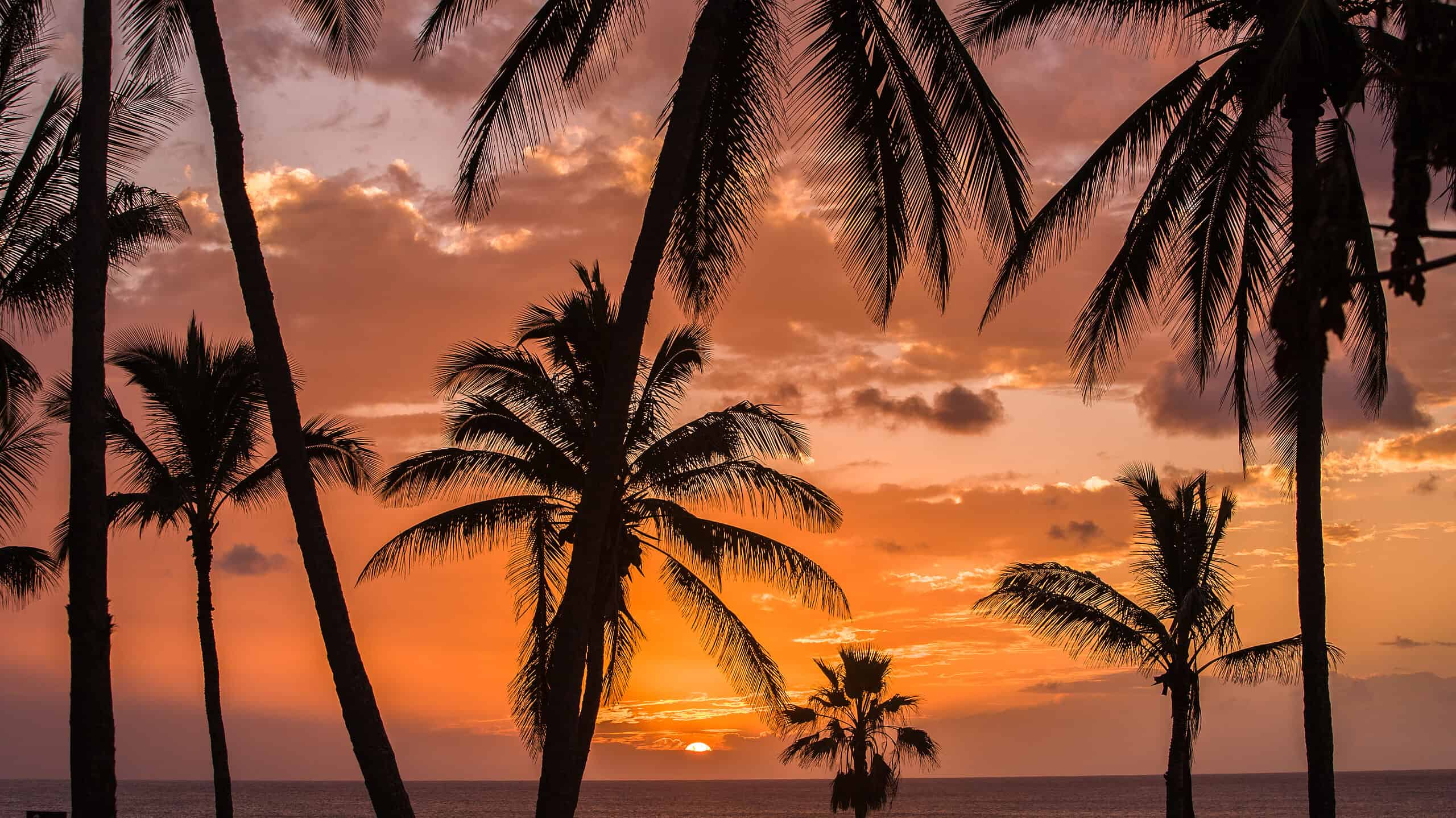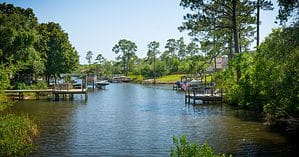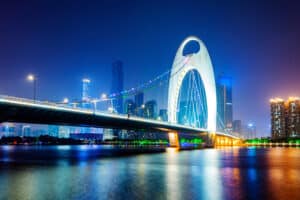While visiting Hawaii, you might think you’ve died and gone to heaven. A short drive from one part of an island to another will show you a different face of paradise. You’ll experience sandy, gently sloping beaches and rocky coastlines with crashing waves. One side of a mountain can be a humid tropical rainforest, while the other side supports different flora and fauna. And behind all this perfect scenery lies a cultural heritage dating back centuries. Let’s take a virtual trip to paradise and explore the oldest cities in Hawaii. We’ll cover when and why they started and what you can do there today.
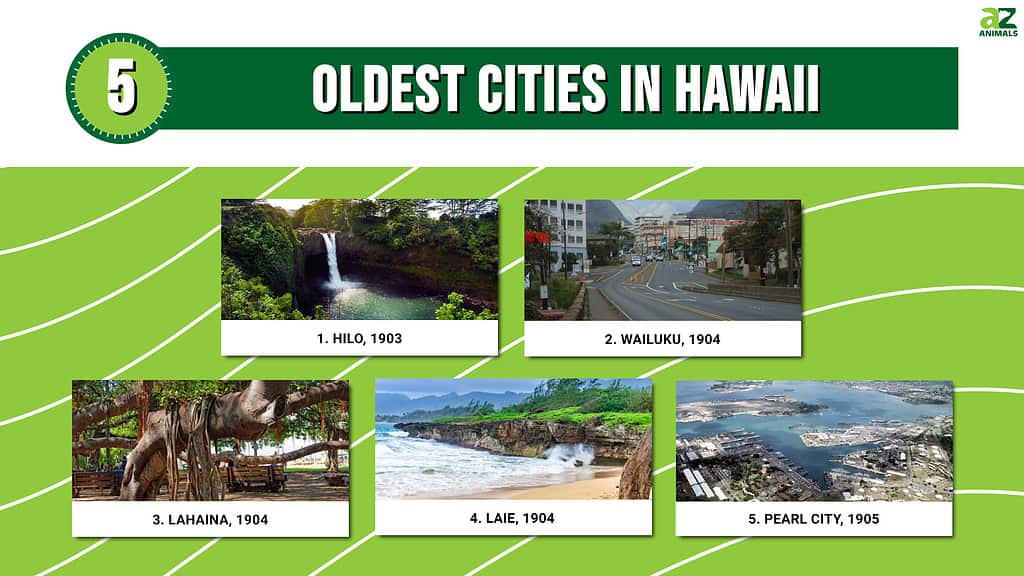
A Little Background
Researchers believe Hawaii was settled by Polynesian people between the years 400-1100 AD. The first white settlers to the islands arrived in the 1820s as Christian missionaries. Colonists followed, with an interest in building profitable plantations. The United States annexed Hawaii in 1898, but it did not become a state until 1959.
It is difficult to pinpoint exactly when a city was “founded” in Hawaii. We assume that every place in Hawaii was potentially inhabited by generations of Hawaiians long before outside settlers arrived. However, dating these settlements is tricky. Purely for the sake of convenience, we’re building our list from more modern cities. This is in no way meant to disrespect the first Hawaiians, whose history long predates European settlements. Additionally, we’re limiting our list to places with a current population of at least 1,500 as of the 2020 census.
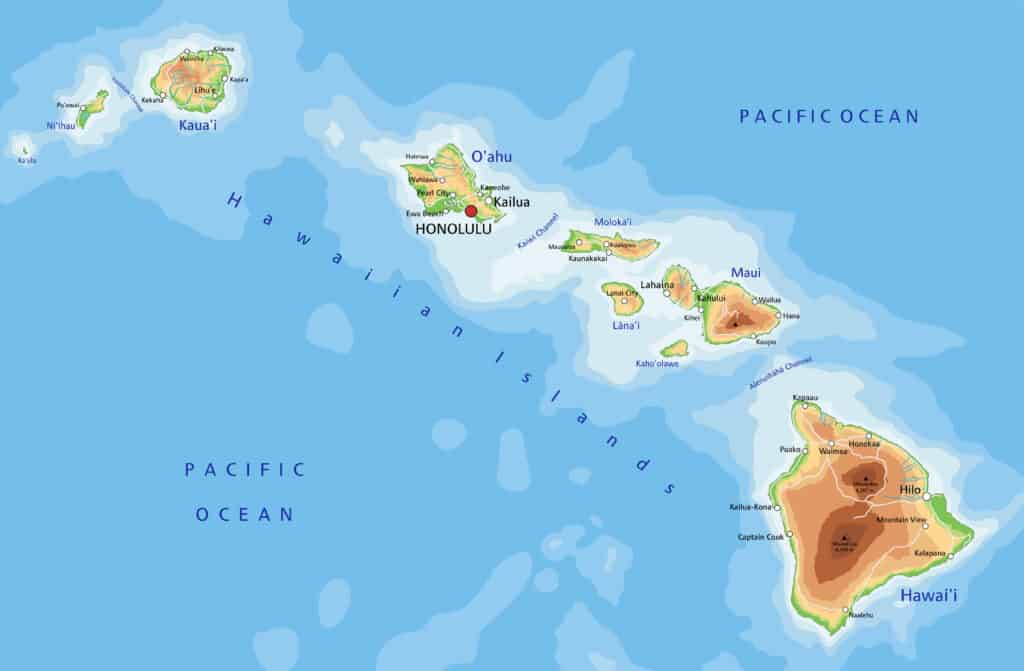
The state of Hawaii is made up of eight major islands, atolls and smaller islets.
©Bardocz Peter/Shutterstock.com
1. Hilo, 1903
The modern city of Hilo dates to 1903. But we know from oral history that this site was inhabited in ancient times. In 2020, its population was 44,186, making it the largest city on the Big Island of Hawaii. It is also the fourth largest in the whole state.
The original inhabitants brought sugar cane with them. However, its cultivation wasn’t expanded into a major export crop until after the islands were colonized by Americans and Europeans. Hilo became a major commercial center for sugar cane production and export. Americans brought tens of thousands of Chinese workers to the islands for this industry. Chinese have over time become woven into the diverse ethnic and cultural fabric of the islands. Hilo has been threatened by lava flows, tsunamis, and economic troubles. But today, it thrives from the tourist industry.
The city overlooks Hilo Bay and has views of two volcanoes: Mauna Loa and Mauna Kea. Mauna Loa is still active and in 1984 lava flows from it reached within four miles of the city limits. Mauna Kea is dormant and home to some of the most important ground-based astronomical observatories in the world. You’ll also find a branch of the University of Hawaii there, the Imiloa Astronomy Center, and the Mauna Loa Macadamia Nut Corporation. Each year, starting on Easter Sunday, you can check out the Merrie Monarch Festival. This week-long cultural event features three nights of ancient and modern hula competitions. Hawaii’s flora are so beautiful and unique! You’ll enjoy the Hawaii Tropical Botanical Garden, Hilo Tropical Gardens, Nani Mau Gardens, and an annual orchid festival. And don’t leave the area without seeing Rainbow Falls & Boiling Pots on the Wailuku River.
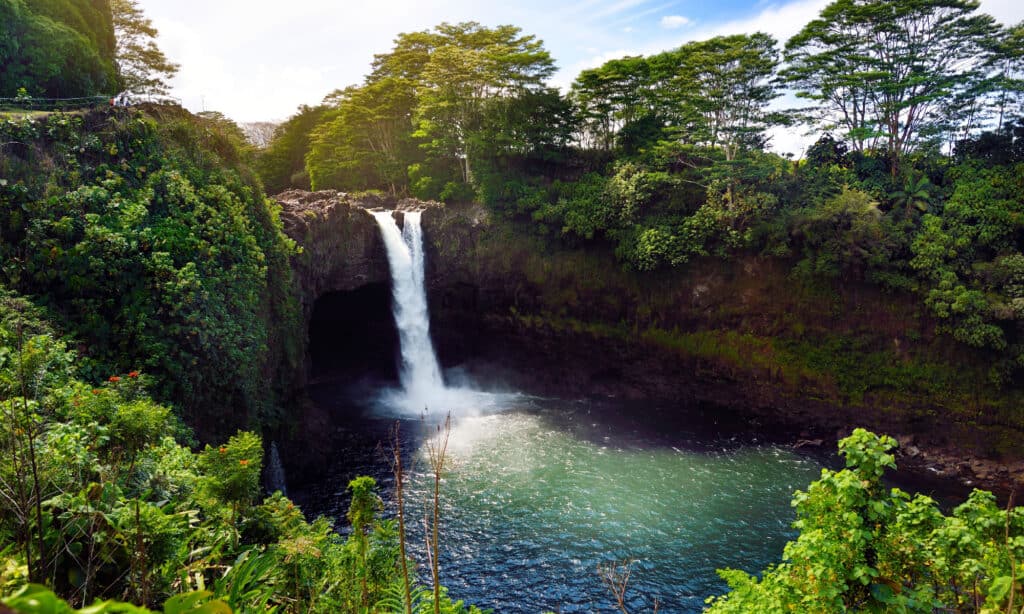
Rainbow Falls is a large waterfall in Hawaii on the Wailuku River that is easily accessible from Hilo.
©iStock.com/MNStudio
2. Wailuku, 1904
Wailuku, with a current population of almost 17,000, was founded on the island of Maui in 1904. It is extraordinarily important in the history of Hawaii. It is the location where King Kamehameha won a decisive victory over other chiefs in 1790. He succeeded in uniting the Hawaiian Islands as one kingdom. Later, it became the center for a significant 19th-century Christian mission station. Wailuku Sugar Company was founded here and became the nucleus of an economically powerful sugar export industry.
Growing sugar took a huge amount of water, requiring the construction of large irrigation works for plantations. This was hugely disruptive to the local people’s way of life. The immigration of large numbers of workers from other parts of Asia, Europe, and America was also disruptive. These immigrants came to work in new factories, stores, and entertainment venues that burgeoned in the city.
Today, near Wailuku, tourists can visit two ancient Hawaiian temples: Halekiʻi Heiau and the Pihanakalani Heiau. From more modern history, visitors can visit the Kaʻahumanu Church, which dates to 1876. Tourists can also visit the Wailuku Civic Center Historic District. Guests also enjoy the Bailey House, a 19th-century former seminary housing a museum and the Maui Historical Society. Every place in Hawaii has gorgeous scenery to experience and Wailuku is no exception. Check out the Lao Valley Park and Rainforest, and the Tropical Gardens of Maui (free of charge). There’s also a museum dedicated to a legendary surfer: Duke Paoa Kahinu Mokoe Hulikohola Kahanamoku. He helped popularize the sport and won five Olympic medals in swimming.
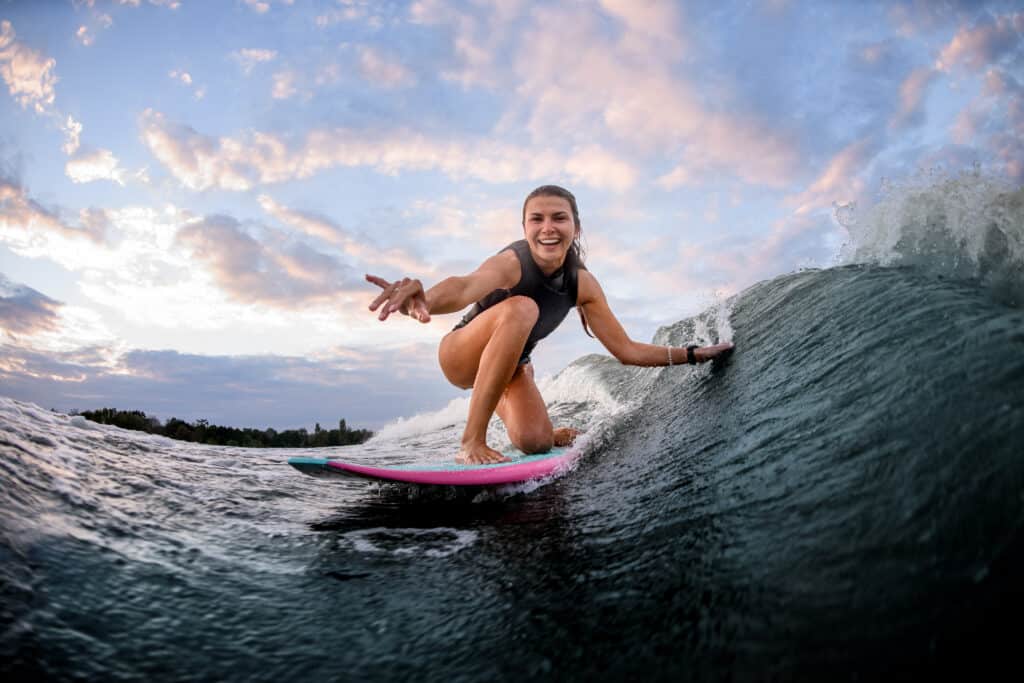
Surfing is one of Hawaii’s many gifts to the world. In Wailuku you can learn how Duke Kahanamoku helped popularize this ultimate cool sport.
©Maksym Fesenko/Shutterstock.com
3. Lahaina, 1904
Lahaina, officially founded in 1904, is a city of about 13,000 today. In the Hawaiian language, the name means “cruel sun” because of its hot and dry climate. Despite this forbidding name, Lahaina was a historic royal city, the capital of the island before the unification of Hawaii, and the site of the palace of King Kamehameha II, who liked it better than crowded Honolulu. With the arrival of foreigners, it became the site of a Christian mission school and the center of the 19th-century whaling industry.
Lahaina continues to attract people of means today. Land in the area is among the most expensive in the state. It’s not uncommon to find homes and condos selling for over $5 million. The American Planning Association ranks Front Street in Lahaina as one of the “Top 10 Greatest Streets.” And while you won’t find whaling ships anymore, the docks are busy with pleasure craft. Besides strolling and shopping on Front Street, you can see the largest Banyan tree in the United States, visit the Bailey Museum, and see the “5 o-clock rainbow,” a picture-worthy moment that happens daily in the valleys of the West Maui mountains. Divers will enjoy visiting the Carthaginian II, a ship purposely sunk in 2005 in 95 feet of water to create an artificial reef about a half-mile offshore.
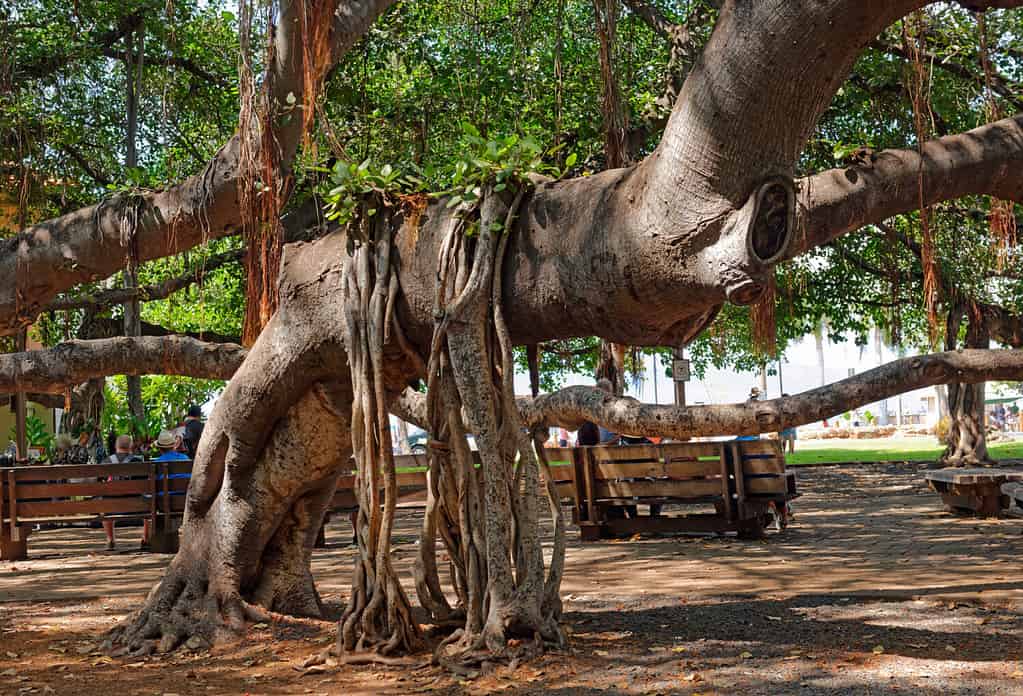
This banyan, planted in 1873 to commemorate 50 years of Christianity in Hawaii, is the largest in the United States.
©Barnes Ian/Shutterstock.com
4. Laie, 1904
Laie, Oahu, with a current population of about 6,000, was historically a place of sanctuary for fugitives, who were defended by priests and could not be killed by their pursuers as long as they were within the city walls. After staying in the refuge for a certain period of time, they could choose to join the priests or reenter the world. Some sparse remains of two ancient Hawaiian temples remain in the area. Americans organized the cultivation of kalo and sugar as export crops. Laie also became a major center for the Church of Jesus Christ of Latter Day Saints, which today operates an extension site of Brigham Young University there.
Millions of visitors flock to the area to see the Polynesian Cultural Center, with 42 acres of garden and water features and six small villages showing the cultures of different parts of the Pacific islands, offering kid-friendly educational experiences and luaus that have been described as the most authentic in Hawaii. The Gunstock Ranch gives children the chance to pet, brush, and ride ponies. Couples can go on horseback rides and have a private picnic, or even take a moonlight ride to watch the moon rise over a scenic overlook. Pahumoa Beach is a particularly popular place for bodysurfing. Those who like hiking, trail running, or mountain biking should check out the 7-mile round trip Laie Falls Trail, to and from a 15-foot waterfall pouring into a pool.
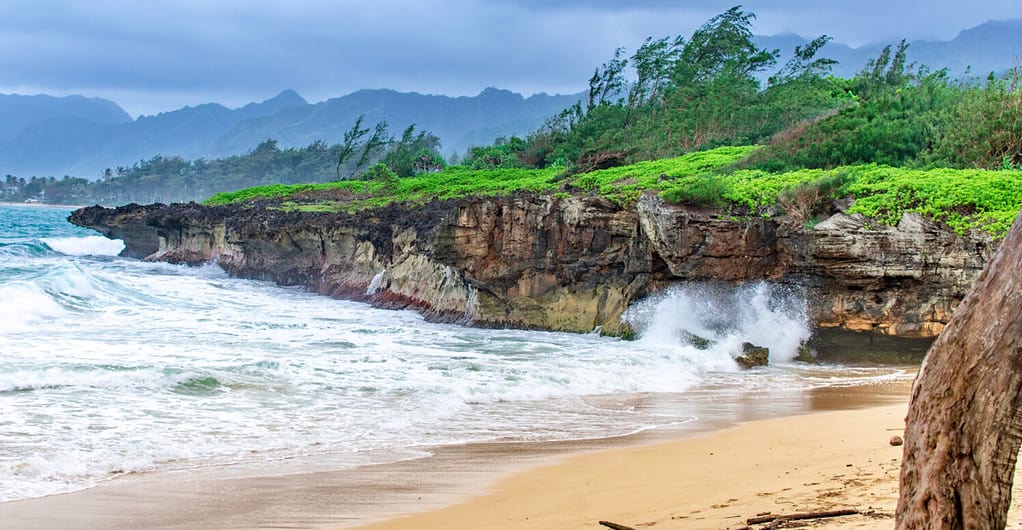
Pahumoa Beach near Laie is a particularly popular place for bodysurfing.
©Hulabear/Shutterstock.com
5. Pearl City, 1905
With a population of about 48,000 people, modern Pearl City, Oahu, was founded on the north shore of Pearl Harbor in 1905. Before then, it was a place of rice paddies and fields plowed with water buffalo. It began to burgeon into a full-fledged city with the building of a rail line. In the early 1900s, Remond Grove on the outskirts of the city attracted music lovers with piano, banjo, trumpet, and saxophone performances.
Most visitors today come for the Pearl Harbor National Memorial, which commemorates the Japanese attack on Pearl Harbor on December 7, 1941, which sank twelve ships and killed 2,400 Americans. The site has an educational center for visitors and the opportunity to take a ferry to the USS Arizona Memorial. It is best to make reservations early as there can be long lines. If you drive 12 miles north of Pearl City, you can visit the Dole Plantation and see what pineapples look like growing in the field. The gift shop has every imaginable pineapple-themed treat and souvenir you could want, including unforgettable pineapple soft-serve ice cream cones.
And pay attention to the trees out front around the parking lot. You’ll think some teenagers covered them with fluorescent paint, but those colors are completely natural! The tree sheds its bark in strips, leaving behind exposed wood that changes color as it ages, from green, to yellow, orange, red, and brown. They look completely other-worldly and pretty much make your whole trip to Hawaii worth the effort and expense.
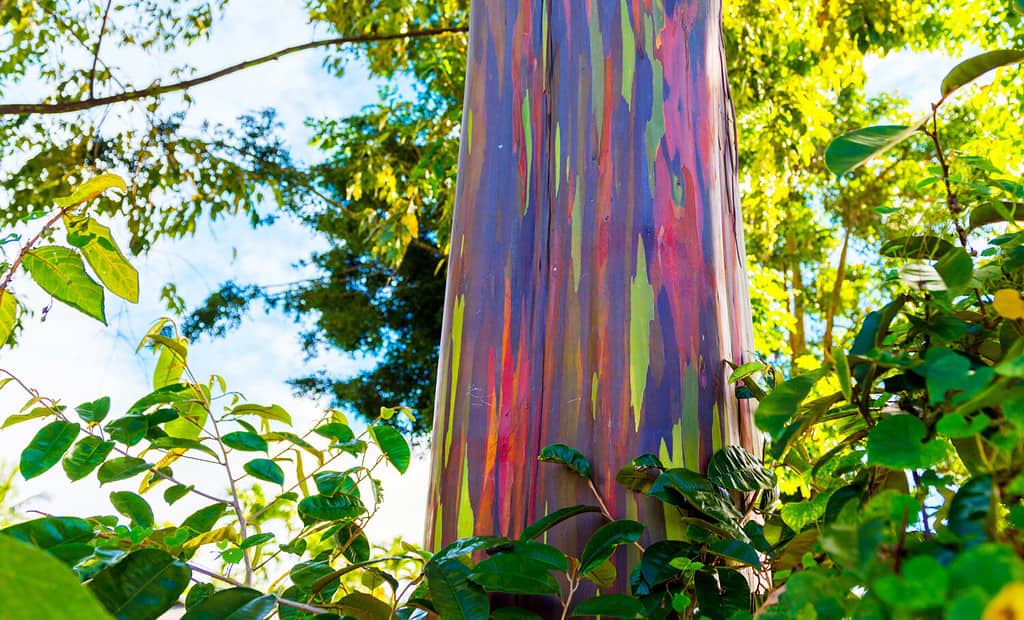
These almost florescent colors on the trunk of the rainbow eucalyptus are the natural colors of the interior of the tree as it ages.
©gg-foto/Shutterstock.com
Pack Your Bags For Hawaii!
We know we had you at “Hawaii.” You’re probably already packed. But maybe pointing out some of the oldest cities in the islands has whetted your appetite for pineapple, macadamia nuts, and a nice luau. And as you enjoy the sights, sounds, tastes, and feeling of being in this paradise, think of the generations before who have loved it and called it home, with gratitude that we have the opportunity to be guests there today.
Summary Of The 5 Oldest Cities In Hawaii
| Rank | City | Date Established |
|---|---|---|
| 1 | Hilo | 1903 |
| 2 | Wailuku | 1904 |
| 3 | Lahaina | 1904 |
| 4 | Laie | 1904 |
| 5 | Pearl City | 1905 |
Thank you for reading! Have some feedback for us? Contact the AZ Animals editorial team.

